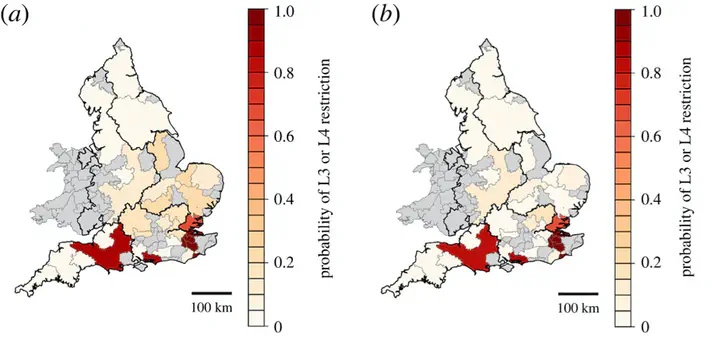Developing an open-source water resource model to inform crucial decisions about the resilience of GB water supplies

Modelled probability of severe water use restrictions occurring in between 2020 and 2050 without (a) and with (b) proposed water resource infrastructure. [Adapted from Murgatroyd et al. (2022)]
–
Unnecessary costs will be saved by the water industry in England and Wales thanks to a new water resources model to be developed by Dr Anna Murgatroyd. The Pywr-WREW model will complement the ongoing National System Simulation Modelling (NSSM) initiative which integrates climate modelling, hydrological modelling and water resources system simulation to inform large-scale strategic water infrastructure planning in England and Wales.
Anna Murgatroyd, OPSIS Research Associate, has been awarded £50,000 funding to rebuild the national Water Resources model for England and Wales using open-source software, which is free to access by stakeholders including the Environment Agency, OFWAT and Water Companies. The project is one of eight, to be sharing £1.4m funding from the Science and Technology Facilities Council as part of the Data & Analytics Facility for National Infrastructures (DAFNI) Centre of Excellence for Resilient Infrastructure Analysis.
Anna said: “We have learned a great deal through the MaRIUS and NSSM projects about extreme drought and climate events on our infrastructure systems. We are starting to see more and more spatially connected droughts between regions and the Pywr-WREW model will help us, and water industry stakeholders, understand what this means for future water supplies.”
The Pywr-WREW model shows how water moves through the water network to the end user. We can simulate that movement, and see the pathway it takes depending on different future climate and socio-economic scenarios. The model allows us to measure water system resilience and robustness to certain climate shocks. From deterioration through droughts to increases in demand from growing populations and housing developments. The model will also be used to test what infrastructure investments and policies may be needed in order to ensure resilient water supplies.
The advance in climate learning over the past decade has shown that droughts are affecting larger areas, lasting longer and are becoming more intense. This new model uses that knowledge to help plan for future climate events. Ultimately it will allow regulators to make better decisions about future infrastructure investments. Although, the cost of implementing the infrastructure will cost millions, the avoided costs and social impacts of water use restrictions on the public will be lessened into the future.
Prof Jim Hall said: “It is important that water companies, regulators and the government have a strategic overview of water resources at a national scale. The WREW model is the most accurate national model of water supplies in England and Wales. By migrating this model to the DAFNI system we will make it more accessible and adaptable, so it can be used to inform crucial decisions about the resilience of water supplies.”
The Environment Agency’s Water Resources Modelling Lead, Dr Jonny Wilson, said: “The work for re-building WREW using the Pywr python library is a key objective in the Environment Agency’s strategic plan for developing national water resources modelling. A python-based version of WREW will make a major stepwise change in national water resources modelling capabilities.”